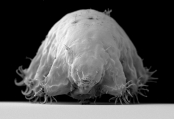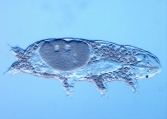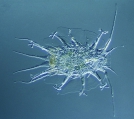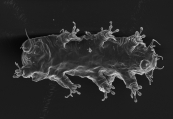World Tardigrada Database
Systematic
The phylum Tardigrada belongs to the Panarthropoda (Onychophora+Arthropoda+Tardigrada) lineage of the Ecdysozoa. The phylum comprises about 1200 species, and it is subdivided into two classes, Heterotardigrada and Eutardigrada, each with two orders (Arthrotardigrada and Echiniscoidea, Apochela and Parachela, respectively).
Current tardigrade alpha taxonomy is mainly based on the morphology of sclerified structures: cuticle, claws/digits, feeding apparatus, and egg shell.
Morphology
Tardigrades, or water bears, are hydrophilous micrometazoans with a bilaterally symmetrical body and four pairs of lobopodous legs, usually terminating in claws and/or, in some marine species, digits. The body is indistinctly divided into three sections: the head (cephalic), three trunk regions (each bearing a pair of legs), and the caudal region (with the fourth pair of legs directed posteriorly). The body is covered by a chitinous cuticle that must be shed as the organism grows. The cuticle can be developed as sclerified plates, with expansions, filaments and obvious external sensory organs (Arthrotardigrada and Echiniscoidea), without sclerified plates but with obvious external cephalic sensory organs (Apochela), and without sclerified plates and either smooth or textured cuticle (Parachela). Although tardigrades range in body length from 40 µm (juveniles) up to 1200 µm (adults), the mature adults average 90–500 µm.
In spite of their miniaturized size, tardigrades have a complex internal organization similar to that of larger animals. They have a relatively large dorsal brain, often with small eye-spots, and a ventral chain of nerve ganglia. The complete digestive system is characterised by mouth parts comprising a piercing and sucking feeding apparatus that is used to suck cell contents of food sources. Dependent on the style of mouth parts, food sources range from bacteria, plants, fungi, cyanobacteria, microalgae, protozoans, to small invertebrates, such as nematodes, rotifers, and other tardigrades. The fluid-filled body cavity (haemocoel) functions as a circulatory system, in respiration, and is rich in free-floating storage cells. Tardigrades have longitudinal and transversal muscles and excretory organs. A single dorsal sack-like gonad with two gonoducts characterises males, while females have only a single gonoduct. In heterotardigrades there is a gonopore while in eutardigrades there is a cloaca for the anus and gonoduct openings. Reproductive strategies include, self-fertilizing hermaphrodites, parthenogenetic females, and sexual reproduction. The eggs are laid free with smooth chorion surface or with a complex ornamental surface (e.g. marine and several limno-terrestrial species), or laid within an old exuvia (cast cuticle – e.g. terrestrial Echiniscoidea and most eutardigrades).
Distribution and ecology
Tardigrades are ubiquitous and very common. Provided the right habitats they are present in all marine environments from coast to abyssal depths, all continents, from high to low altitude, all latitudes, from North to South, and environments that range from aquatic to arid deserts, frozen ice, through temperate to tropical conditions.
Tardigrades originated from the marine environment, where 200 extant arthrotardigrade species have been identified as part of the meiobenthos (very few eutardigrade species are secondarily marine). Marine habitats for tardigrades include, living within the interstitial spaces of coarse sediments or epibenthic on rocks of intertidal and sub-tidal areas down to the abyss (4690 m), and associated with algae (e.g. holdfasts) and other invertebrates (e.g. barnacles, sea cucumbers). About 960 species of extant limno-terrestrial tardigrades have been identified and belong to the Echiniscoidea and Eutardigrada. These animals colonise terrestrial habitats such as: moss, lichen, leaf litter, liverwort, soil and turf; while the obligate limnic species (of which there are only about 40), primarily belong to the eutardigrades, with very few truly limnic echiniscid species. Freshwater lentic and lotic environments include: lakes, ponds, pools, swamp, marsh, ephemeral ponds, rivers, streams, and canals, with habitats including: the interstitial spaces of sediments and cyanobacterial/ algal mats, and epiphytically on aquatic higher plants.
Cryptobiosis
Terrestrial tardigrades are essentially aquatic animals needing a film of water surrounding their body for active life (i.e. moving, growing, eating, reproducing, etc.). However, tardigrades have the remarkable ability to survive desiccation in ‘resting stages’, which enables them to survive extreme and unpredictable living conditions (e.g. the wet/ dry conditions of exposed moss and lichen). The tardigrade resting states embrace a wide range of dormancy strategies including diapause (encystment) and cryptobiosis (tuns). Cryptobiotic tardigrades are able to withstand desiccation (anhydrobiosis) and freezing (cryobiosis) at any stage of their life-cycle, suspending their metabolism completely in the absence of liquid water. When favourable environmental conditions return, i.e. liquid water is available, active life is restored.
Links
- Updated check list of tardigrades species a PDF file that is kept up-to-date with a list of all tardigrade taxa
- Tardigrada Newsletter a comprehensive service and platform for the worldwide community of tardigradologists
- Tardigrada Register which is gradually being populated with morphometric, molecular and zoogeographic data on new species
Citation
Usage of data from the World Tardigrada Database in scientific publications should be acknowledged by citing as follows:- Guidetti, R.; McInnes, S.J.; Kristensen, R.M. (2025). World List of Tardigrada. Accessed at https://www.marinespecies.org/tardigrada on 2025-12-15. doi:10.14284/361
Individual pages are individually authored and dated. These can be cited separately: the proper citation is provided at the bottom of each page.
Editors
Image credits
- Marine tardigrade Floractus heimi (R. M. Kristensen)
- Marine tardigrade Echiniscoides sp (S. J. McInnes)
- Marine tardigrade Batillipes sp. (C. Schulze & A. Schmidt-Rhaesa)
- Limnoterrestrial tardigrade Acutuncus antarcticus (R. Guidetti)



